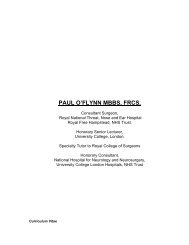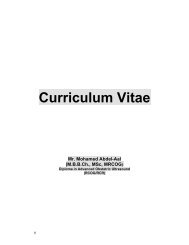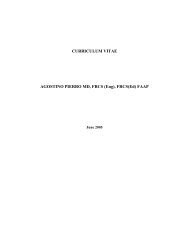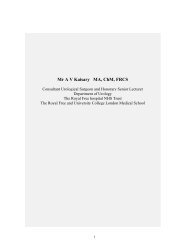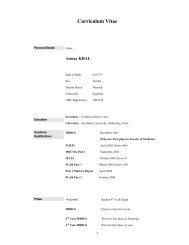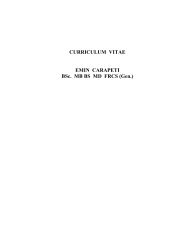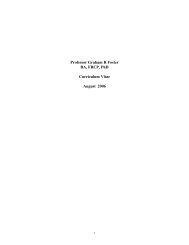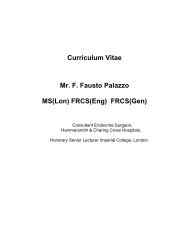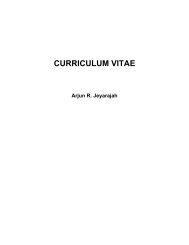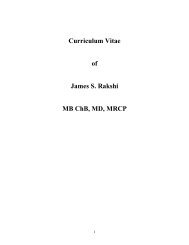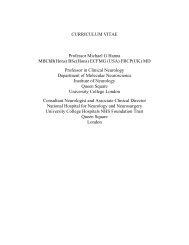professor janice rymer - Servo Medical health care Egypt by Servo ...
professor janice rymer - Servo Medical health care Egypt by Servo ...
professor janice rymer - Servo Medical health care Egypt by Servo ...
Create successful ePaper yourself
Turn your PDF publications into a flip-book with our unique Google optimized e-Paper software.
CURRICULUM VITAE<br />
PROFESSOR JANICE RYMER<br />
MD FRCOG FRANZCOG ILTM
DATE OF BIRTH: 23rd July 1958<br />
EDUCATION:<br />
1970-1975 - Diocesan School for Girls Auckland, New Zealand<br />
1975 ..- Dux of School, Head Prefect<br />
1976-1981 - Auckland School of Medicine, New Zealand<br />
QUALIFICATIONS:<br />
1978 - Bachelor of Human Biology, Auckland<br />
1981 - MB ChB, Auckland<br />
1983 - DRCOG<br />
1987 - MRCOG<br />
1988 - MRNZCOG<br />
1990 - FRANZCOG<br />
1991 - Accreditation for Higher Training, RCOG<br />
1994 - MD, Auckland<br />
2002 - ILTM (Member of Institute of Learning and Teaching)<br />
2005 - FRCOG<br />
REGISTRATIONS:<br />
1982 - New Zealand <strong>Medical</strong> Council<br />
1986 - General <strong>Medical</strong> Council
SOCIETIES:<br />
• Blair Bell Research Society<br />
• South East Thames Gynaecological Society<br />
• Society of British Gynaecological Endoscopy<br />
• British Menopause Society<br />
• International Society of Gynaecological Endocrinology<br />
• International Menopause Society<br />
• Gynaecological Research Society<br />
EXTRAMURAL POSITIONS:<br />
• Examiner for DRCOG – 1992 – 1996<br />
• Member, DRCOG Examination Committee – 1992 – 1996<br />
• Examiner for MRCOG Part II – 1996 -<br />
• Chairman, MRCOG Part II, Oral Examination Committee – 1998 – 2001<br />
• Member, RCOG Examinations Committee – 1998 – 2001<br />
• Deputy Chairman, Year IV Committee, GKT – 1996 – 2001<br />
• Chairman, RSH Block Committee, GKT – 1996 – 2001<br />
• Member, GKT Education Committee – 1991 – 2000<br />
• Member of SIFT committee, GKT – 1998 – 2001<br />
• Council Member - British Menopause Society – 1997 – 2002<br />
• Member - RCOG Committee for Implementation of Structured Training – 1995 – 1997<br />
• External Examiner: Birmingham University – 1996 – 1999<br />
Manchester University – 1999 – 2002<br />
Imperial College – 1999 -<br />
Queen Mary, University of London – 2001 – 2004<br />
Royal Free Hospital, University College London – 2001 – 2004<br />
St George’s Hospital 2005 -<br />
• Member, RCOG Appeals Committee – 1999 – 2005<br />
• Member of RCOG Council 1999 – 2005<br />
• Member of RCOG Standards Board – 2001 – 2004<br />
• Member of RCOG Finance and Executive Group – 2001 – 2002<br />
• Member of Editorial Board – Journal of Obstetrics and Gynaecology – 2002 –<br />
• Member of RCOG Services Committee – 2002 – 2005<br />
• Member of GMC team to assess Hull and York <strong>Medical</strong> School – 2001 –<br />
• Convenor of Part II MRCOG Courses at RCOG – 2002 – 2005<br />
• Continuing Professional Development Officer of RCOG – 2005 –<br />
• Member of RCOG PMETB Equivalence Board – 2005 –<br />
• Member of PMETB Appeals Board – 2005 -<br />
PRESENT APPOINTMENT:<br />
2
Professor of Obstetrics and Gynaecology, King’s College London School of Medicine – 2005 -<br />
PREVIOUS APPOINTMENTS:<br />
April 2004 - 2005<br />
- Senior Lecturer/Honorary Consultant, King’s College London<br />
Dec 1991 - April 1994 - Locum Consultant, Guy’s Hospital, London<br />
Aug 1989 - Nov 1991 - Senior Registrar in Obstetrics/Gynaecology, Guy’s Hospital, London.<br />
Mar 1989 - Aug 1989 - Research Fellow/Lecturer, Guy’s Hospital, London.<br />
Feb 1988 - Mar 1989 - Registrar in Obstetrics and Gynaecology, Guy’s Hospital, London.<br />
Mar 1987 - Jan 1988<br />
Jun 1986 - Mar 1987<br />
Dec 1985 - Jun 1986<br />
- Registrar in Obstetrics and Gynaecology, Wycombe General<br />
Hospital, High Wycombe, Buckinghamshire, UK.<br />
- Registrar in Obstetrics and Gynaecology, National Women’s and<br />
Middlemore Hospitals, Auckland, New Zealand<br />
- Registrar in General Surgery (RCOG Elective) Northland Base<br />
Hospital, Whangarei, New Zealand<br />
Dec 1984 - Dec 1985 - Registrar in Obstetrics and Gynaecology, National Women’s<br />
Hospital, Auckland<br />
May 1984 - Nov 1984 - Senior House Officer in Obstetrics/Gynaecology, National Women’s<br />
Hospital, Auckland<br />
Nov 1983 - May 1984 - <strong>Medical</strong> Officer in Obstetrics and Gynaecology, Rumah Sakhit<br />
Emmanuel, Bandung, Indonesia<br />
May 1983 - Nov 1983 - Senior House Officer in Paediatrics/General Medicine (RCOG<br />
Elective) Auckland Hospital Board, New Zealand<br />
Nov 1982 - May 1983 - Senior House Officer in Obstetrics/Gynaecology, Middlemore<br />
Hospital, Auckland<br />
Nov 1981 - Nov 1982 - House Officer in Surgery and Medicine, Auckland Hospital Board<br />
The activities I have pursued are listed below under the following sections:<br />
1. Clinical experience<br />
2. Teaching<br />
3. Research<br />
4. Publications<br />
5. Scientific Meetings<br />
6. Administration<br />
7. Standing in the profession<br />
3
1. CLINICAL EXPERIENCE<br />
Basic Training<br />
My basic postgraduate training was done in New Zealand in the National Women’s Hospital (5,000<br />
deliveries annually), an extremely busy unit with a wide range of obstetrics and gynaecological<br />
problems. Part of the time was spent at Middlemore Hospital (6,500 deliveries annually) dealing<br />
primarily with a population of Pacific Islanders. During this time I had a regular on-call<br />
commitment for obstetrics, and as a registrar, played a vital role in co-ordinating the labour ward<br />
activities. In gynaecology my surgical training was commenced with a strong emphasis on vaginal<br />
surgery.<br />
Obstetrics<br />
At National Women’s I worked with Professor Liggins, Professor Liley and Professor Lubbe whose<br />
special interests were fetal physiology, rhesus disease, and SLE respectively. At Middlemore I ran<br />
the diabetic antenatal clinic (in conjuction with a physician). This was a large clinic due to the high<br />
incidence of gestational diabetes in Pacific Islanders.<br />
In Indonesia, I was exposed to obstetrics in the Third World. This post provided invaluable<br />
experience in managing problems with minimal resources and it demonstrated to me the importance<br />
of standardised approaches for <strong>care</strong>, in order to optimise the perinatal and maternal outcomes. At<br />
Guy’s the problems of a busy urban hospital servicing a diverse socioeconomic population<br />
developed my skills in dealing with both obstetric emergencies and ethnic communication.<br />
In December 1991, I was appointed as Professor Chapman’s locum and the obstetric workload was<br />
in excess of 750 patients. As a senior lecturer I have continued with obstetrics, and now run a<br />
community clinic in Deptford and have in-patient beds at St Thomas’ and a regular on-call<br />
commitment.<br />
Gynaecology<br />
In terms of gynaecological experience, I have had a sound basis of training, initially in New<br />
Zealand in a teaching hospital environment. The unit was renowned for vaginal surgery in<br />
particular. I then worked in a busy district general hospital in the United Kingdom. There, the<br />
surgical experience was extensive with three of my own operating lists per week. At Guy’s I was<br />
able to widen my operative skills under the guidance of Consultants with expertise in<br />
urogynaecology and oncology. This experience has provided me with core surgical skills. In<br />
addition, I introduced Gynaecological Minimally Invasive Surgery into the Department in 1992.<br />
Throughout my training I have been involved in colposcopy and have run clinics in New Zealand,<br />
High Wycombe and at Guy’s.<br />
My elective time was spent in general medicine, paediatrics, and general surgery. The latter was at<br />
registrar level with a 1 in 2 rota, which has given me invaluable confidence in general surgical<br />
operating.<br />
4
Minimally Invasive Surgery<br />
I have been accredited <strong>by</strong> the RCOG as a preceptor in Minimally Invasive Surgery. I represent the<br />
Gynaecological Department on the Guy’s and St. Thomas’ MIT unit, and I was substantially<br />
involved in putting together the Guy’s grant for the Woolfson Trust in 1993.<br />
I have attended, and actively participated in a number of courses in Europe and in the United States<br />
to acquire various operative techniques.<br />
I am now competent to perform and teach laparoscopic hysterectomy, adhesiolysis, ovarian<br />
cystectomy, laparoscopic management of ectopic pregnancy, and laparoscopic colposuspensions.<br />
Together with the Business Manager for the O&G Department in 1992, I was successful in a bid<br />
for £40,000 to set up a Minor Procedures List. This has proved very successful as patients are seen<br />
and treated at the same visit. As well as increasing the efficiency of our service it enabled me to<br />
purchase an ultrasound scanner for the Registrars to use thus increasing the efficiency of our “oncall”<br />
service. The funding has also enabled me to set up out-patient hysteroscopy which is proving<br />
very successful. The “Minor Procedures Clinic” now has six sessions/week, offering outpatient<br />
hysteroscopy. I have set up a training laboratory for laparoscopic skills predominantly for the GKT<br />
SSM students, but also available for any members of our directorate or department.<br />
Female Genital Mutilation<br />
With our increasing refugee population an FGM clinic was set up in 1996. I have been the lead<br />
consultant and run the clinic with a midwife. Initially we did all the reversals under general<br />
anaesthesia but as we have gained more experience we now do them all under local anaesthesia at a<br />
“one-stop” clinic. From 1996 to 2002 I performed all the reversals, but I have now taught the FGM<br />
midwife who does the majority of straightforward cases.<br />
In conjunction with the FGM midwife we run national study days on FGM twice a year.<br />
2. TEACHING<br />
Throughout my <strong>care</strong>er I have been actively involved in and enjoyed teaching, both to medical and<br />
midwifery staff.<br />
My sustained leadership in teaching and learning, successful innovation in programme and course<br />
design and delivery in undergraduate education, and my national and international contribution to<br />
postgraduate specialist training were recognised in the award of Membership of the Institute of<br />
Learning and Teaching in 2002.<br />
UNDERGRADUATE TEACHING<br />
Reproductive and Sexual Health Course<br />
I am the senior academic responsible for undergraduate education in Reproductive and Sexual<br />
Health (RSH) at Guy’s, King’s and St Thomas’ (GKT) School of Medicine. Reproductive and<br />
Sexual Health includes obstetrics and gynaecology, family planning, genitourinary medicine and<br />
breast medicine.<br />
5
I lead on all aspects of organisation including course work, audit and firm attachments. I produced<br />
the core curriculum material for RSH for the most recent GKT curriculum. I am responsible for<br />
evaluating the teaching, both on our medical school campuses and at our peripheral hospitals,<br />
which include both national and international sites.<br />
The high quality of this programme has been confirmed <strong>by</strong> a robust system of feedback which<br />
consists of written feedback from the students for all symposia in the second term of each year,<br />
written feedback from the students at the end of each year regarding their clinical attachments and<br />
tutorial programme (both at the campus sites and peripheral hospitals), and formal sessions at the<br />
beginning of each term where the students are given the opportunity to provide critical feedback<br />
about the RSH programme that they completed the term before to teachers who are not involved in<br />
the RSH programme<br />
Examining<br />
I also led the school of medicine in the use of Objective, Structured Clinical Examinations<br />
(OSCEs), which are a systematic method of assessment of clinical performance and competence.<br />
My department was the first to use this method of assessment and I was keen to introduce this<br />
because of my previous experience at the Royal College of Obstetricians and Gynaecologists<br />
(RCOG) where I was involved in the first OSCE exams performed there. Because this was a<br />
qualifying examination for the UMDS students, I was required to appoint external examiners whose<br />
reports indicated the OSCE was of a high standard and superior to the previous form of assessment.<br />
OSCEs are now used throughout the school of medicine as end of year and end of course exams.<br />
Research and Advancement of Teaching Methods<br />
An integral part of my teaching approach is to involve students as much as possible in my clinical<br />
and research work. At UMDS, I supervised over thirty student clinical projects. The GKT<br />
curriculum now includes special study modules (SSMs) which account for 20% of clinical time.<br />
One of my areas of clinical expertise is minimal access surgery (keyhole surgery) and I now run a<br />
SSM each term so that students develop skills in day surgery and develop laparoscopic skills in the<br />
training laboratory that I have set up for them. This SSM is extremely popular and always<br />
oversubscribed. At the end of the SSM the students are formally assessed <strong>by</strong> nursing and medical<br />
colleagues not involved in the SSM, who have been amazed that over the 12 weeks the students<br />
have achieved a level of laparoscopic dexterity that is superior to many of our junior doctors.<br />
In collaboration with Dr Paula Baraitser, Consultant in Community Gynaecology, we won a grant<br />
from the Charitable Foundation of the special trustees of Guy’s and St Thomas’ Hospital to train<br />
Gynaecology Teaching Associates (GTAs) to set up a teaching programme for the students in the<br />
RSH block. This project involved us teaching laywomen how to perform pelvic examinations, who<br />
in turn teach medical students how to do the examinations. Two GTAs work with groups of four<br />
medical students; one GTA acts as the teacher and one as the patient. This innovative project has<br />
been highly successful (as judged <strong>by</strong> formal student feedback) and has lead to a publication in the<br />
British <strong>Medical</strong> Journal. GKT has now provided mainstream funding for this project so that all<br />
medical students in the RSH block will be taught <strong>by</strong> GTAs and this programme is likely to be<br />
implemented in other medical schools.<br />
I have been active in educational research on other topics, particularly at the interface between<br />
patient <strong>care</strong> and medical education. I have published in the BMJ about women’s reactions to the<br />
presence of medical undergraduates in the gynaecology clinic and have recently completed two<br />
medical surveys on the increasingly important and sensitive issues of chaperones. We have<br />
collected valuable data, now submitted for publication, on the attitudes of GPs and hospital<br />
specialists in the provision of third parties during intimate examinations in primary and secondary<br />
<strong>care</strong> settings. I represent Obstetrics and Gynaecology in the recently established GKT Division of<br />
Educational Research.<br />
POSTGRADUATE TEACHING<br />
6
For the past fourteen years I have organised the Guy’s DRCOG course for 44 candidates every six<br />
months. This course is now reputed to be the leading course in the UK for the DRCOG and has a<br />
very high pass rate. With the introduction of OSCEs into the DRCOG examination, my course has<br />
been chosen to validate the questions. I served on the DRCOG OSCE committee from 1993-1998<br />
and was chief examiner in London for the DRCOG from 1995-1998. I was the chairman of the Part<br />
II MRCOG OSCE committee and responsible for setting the examination from 1999-2001. I am an<br />
overseas examiner for the MRCOG.<br />
I am now the convener for the RCOG Part II courses for the MRCOG, which includes 2 written and<br />
2 OSCE courses per year. Previously, the course was mainly lecture based but I have radically<br />
changed the written course to small group teaching and the candidates are required to do precourse<br />
preparation, presenting Power Point summaries with a facilitator. The OSCE course involves<br />
practice circuits with feedback and interactive group sessions. This style has raised the profile of<br />
the course and has received excellent feedback.<br />
Pre-registration House Officers (PRHOs)<br />
Over the last 3 years, pre-registration house officers have joined our junior doctor workforce and I<br />
am responsible for their clinical training. This is a very close relationship as they are directly under<br />
my supervision, and because of their protected clinical time they have more direct contact with the<br />
patients than the other junior doctors who have such varied rotas. I have received excellent<br />
feedback from both the PRHOs and the Postgraduate Dean on the attachment and gynaecology is<br />
now one of the most popular rotations.<br />
Multidisciplinary Teaching<br />
I am an accredited preceptor in Minimal Access Surgery for the RCOG. This means that my<br />
juniors are trained, and then accredited <strong>by</strong> me as being competent in Minimal Access Surgery.<br />
My clinical activities have led to two particularly interesting and successful multidisciplinary<br />
teaching innovations. Deborah Holloway is the first consultant nurse gynaecologist to be appointed<br />
in our Trust. I have trained her to not only be competent in menopause management but also to<br />
perform hysteroscopies (endoscopic visualisation of the uterine cavity) in the outpatient setting.<br />
Some years ago I was granted an award from the National ‘Pace-setters’ fund to set up a minor<br />
procedures clinic. This has been extremely successful, now with 4 clinics a week, and has meant<br />
many operations have been shifted from an inpatient or day surgery procedure under general<br />
anaesthetic to an outpatient procedure performed under local anaesthetic.<br />
I am also responsible for a clinic, which reverses genital mutilation that has been performed on<br />
women in certain cultures. In this clinic, I have also trained a midwife in the surgical procedure so<br />
that she too can perform the reversal in an outpatient setting. She was recently awarded the prize for<br />
‘Best Nurse/Midwife’ in the Trust – 2003.<br />
Additionally, my clinics attract people from genitourinary medicine, community gynaecology, and<br />
general practice, not to mention international doctors keen to learn minimal access outpatient<br />
techniques or menopause management.<br />
TEXTBOOKS<br />
I am the first author of five textbooks for both undergraduate and postgraduate education. My<br />
textbook ‘Preparation and Revision for the DRCOG’ is the recommended text for the Diploma for<br />
the RCOG, which is the licensing examination for general practitioners to practice antenatal <strong>care</strong><br />
and gynaecology in the primary <strong>care</strong> setting. The book has been highly successful for<br />
undergraduates as well, and the third edition has just been published (2003).<br />
7
‘Colour Aids in Gynaecology’ is an illustrated text, which was first published in 1991. This is a<br />
very popular book for anyone learning gynaecology and the 3 rd Edition has now been published.<br />
Carrying on from its publication, I have produced ‘Gynaecology in Focus’, which includes photos<br />
with questions and answers to enhance the learning experience.<br />
In conjunction with paediatric and obstetric colleagues I designed a collaborative CD Rom for<br />
Neonatal Medicine, Obstetrics and Gynaecology (James, Harvey, Rymer, Thomas, Fish, Hyer) and<br />
we were awarded the BMA Award for the Electronic Media Section (2001).<br />
Following on from the above Colour Aids, I produced ‘Pictorial Quizzes in Obstetrics and<br />
Gynaecology’ which was acclaimed as excellent revision for students for examination preparation.<br />
Once the popularity of OSCEs increased, I published ‘OSCES in Obstetrics and Gynaecology’,<br />
which is used <strong>by</strong> both undergraduates and postgraduates preparing for the DRCOG and MRCOG.<br />
‘Preparing for the DRCOG’ is a revision book of multiple choice questions for the DRCOG but also<br />
used <strong>by</strong> undergraduates.<br />
‘How to Pass the MRCOG OSCE’ — a guide on OSCE technique, which is an essential tool for all<br />
candidates taking the MRCOG.<br />
‘Pocketbook of Obstetrics and Gynaecology’ is a ‘pocket essential’ providing comprehensive<br />
coverage for the undergraduate and postgraduate student in the popular Kumar/Clarke series. It is<br />
also available as hand held software.<br />
‘Gynaecology in Focus’ — Similar to Colour Aids but with the addition of questions and answers.<br />
In Press<br />
‘Top Twenty in Gynaecology’ is an illustrated text of the commonest presentations in<br />
Gynaecology.<br />
‘Colour Atlas of Gynaecology’ — a comprehensive textbook of gynaecological conditions.<br />
REGULAR EDUCATIONAL COMMITMENTS<br />
DRCOG Course, Guy’s Hospital<br />
St. Bartholomew’s Hospital DRCOG Course<br />
Emergency Nurse Practitioners Programme<br />
Olive Haydon School of Midwifery<br />
Camberwell Family Planning Course<br />
Guy’s & St. Thomas’ Hospital Senior House Office Induction Course<br />
Guy’s & St. Thomas’ Hospital Operating Assistant Training Programme<br />
Whipps Cross MRCOG Course<br />
RCOG MRCOG Course<br />
MRCOG Course - Republic of Ireland<br />
Guy’s and St. Thomas’ Hospital, GP update course<br />
Margaret Pyke Update Course<br />
3. RESEARCH<br />
Throughout my postgraduate training I have been involved in clinically based research. This has<br />
included projects on the use of prostaglandins in spontaneous rupture of membranes, the markers of<br />
hypertensive disease in pregnancy, and clinical audit in obstetrics which was a comparative trial of<br />
prostaglandin gel and tablets.<br />
8
Over the past fifteen years my research interests have been more gynaecologically orientated and<br />
has mainly involved osteoporosis, new forms of HRT and their effect on symptoms, the<br />
endometrium and cardiovascular disease. In 1990 I established the Guy’s HRT Research Unit.<br />
More recently I have been involved in educational research.<br />
MD Thesis<br />
The subject of this work was HRT and in particular a non-bleeding form of HRT, tibolone and its<br />
effect on osteoporosis, cardiovascular disease and other parameters. Since completion of my MD<br />
my interest in ovarian failure has continued and I established the HRT Research Unit which now<br />
involves many projects. The unit does collaborative research with the Departments of Nuclear<br />
Medicine, Pharmacology, Breast Surgery, Dermatology, Neuropharmacology, Clinical<br />
Biochemistry, Cardiology, and Wound Healing.<br />
Over the last six years research under my direction has attracted the following funding:<br />
• Organon Laboratories<br />
OD14 study £500,000<br />
Livial change over study £94,000<br />
Carotid artery scanning £50,000<br />
Livial CIMT study £203,100<br />
Tamoxifen Breast Cancer Study £24,000<br />
• Sandoz Pharmaceuticals<br />
Combined HRT £300,000<br />
• International Health Foundation<br />
Research survey £1,000<br />
• Minor Procedures List<br />
(Pace-Setter’s Fund) £40,000<br />
• Sanofi-Winthrop £17,800<br />
• Clintrials £40,00<br />
• Alza Coporation £30,000<br />
• GnRHa with Livial Addback Therapy £14,000<br />
• St. Thomas’ Special Trustees £70,000<br />
• Dunhill Trust (with Professor File) £103,000<br />
• Dunhill Trust £115,000<br />
• Wyeth Laboratories (with Professor Murphy) £100,000<br />
Appendix A - Research Fellows<br />
Surya Gupta – currently finishing her project, which investigates the effects of vaginal versus<br />
systemic HRT on bladder function.<br />
Deborah Bruce - having successfully gained a Dunhill Trust grant she investigated the effect of<br />
non-bleeding hormone replacement therapies on endothelial function. MD thesis awarded October<br />
2004.<br />
9
Edward Morris - has completed two years investigating GnRHa and addback therapy as a model<br />
for long-term management of fibroids. MD thesis awarded 2002.<br />
Barry O’Reilly - having been awarded a Special Trustee’s Grant he investigated purinergic<br />
receptors in the bladder. MD thesis awarded 2001.<br />
Emma Parry - a previous UMDS graduate. I supervised her MD thesis on “Induction of Labour:<br />
How, Why and When ?” MD thesis awarded 2002.<br />
Has Ahmed - 1994-1996 - investigated a continuous combined HRT and its effect on bone and the<br />
cardiovascular system. Planned to write up his MD thesis but hasn’t yet. Published three<br />
significant papers, one of which was in the Lancet.<br />
Melissa Calvin PhD - 1999 - one of the first intercalated UMDS, PhD students. Investigated the<br />
effect of oestrogen on wound healing. Supervised jointly <strong>by</strong> Dr. Dyson, Dr. Young and myself.<br />
Additional Research Projects<br />
• Lipoprotein (a) in pregnancy<br />
• New non bleeding HRTs and effect on bone density<br />
• Weight gain with HRT<br />
• Vascular response to HRT<br />
• Breast cancer and HRT<br />
• Tamoxifen and the endometrium<br />
• Patients attitudes to medical students in the gynaecologic consultation, and on the labour ward<br />
Awards<br />
Young Investigators Award for “Prediction of Bone Loss with Biochemical Markers”. Fourth<br />
International Symposium on Osteoporosis. Hong Kong 1993.<br />
BMA award for the Electronic Media Section (2001) for CD ROM on Neonatal Medicine,<br />
Obstetrics and Gynaecology.<br />
4. PUBLICATIONS<br />
Books<br />
Rymer, JM, Davis, G, Rodin A, Chapman, M (1990). Preparation and revision for<br />
the DRCOG. Published <strong>by</strong> Churchill Livingstone<br />
Rymer, JM, Fish, A J, Chapman M (1991). Colour aids in gynaecology. Published<br />
<strong>by</strong> Churchill Livingstone.<br />
Rymer, JM, Lombardi, E (1994). Pictorial quiz in obstetrics and gynaecology.<br />
Published <strong>by</strong> Churchill Livingstone. ISBN 0443049505<br />
Rymer JM, Higham J. (1996) Preparing for the DRCOG. Kluwer Academic<br />
Publishers. ISBN 0792388755<br />
10
Rymer, JM, Fish, A J, Chapman M (1997). Colour aids in gynaecology. Published<br />
<strong>by</strong> Churchill Livingstone. - 2nd Edition. ISBN 0443057753<br />
Rymer, JM, Ahmed, H A. (1998) OSCES in obstetrics and gynaecology. Published<br />
<strong>by</strong> Churchill Livingston. ISBN 0443056102<br />
Rymer, JM, Davis, G. Rodin A, Chapman, M (1998). Preparation and revision for<br />
the DRCOG. Published <strong>by</strong> Churchill Livingstone, 2nd Ed. ISBN 044305097X<br />
Rymer, JM, Davis, G, Rodin, A, Chapman, M. (2003). Preparation and revision for<br />
the DRCOG. Published <strong>by</strong> Churchill Livingstone, 3 rd Ed. ISBN 0443072248<br />
Rymer J, Fish A (2005) – Gynaecology in Focus. Published <strong>by</strong> Elsevier. ISBN<br />
0443074372<br />
O’Reilly B., Bottomley C., Rymer J. (2005) Pocket Book of Obstetrics and<br />
Gynaecology. Elsevier Publishers. ISBN 0702028134<br />
In Press<br />
Rymer JM, Fish, AJ. Gynaecology In Focus, Elsevier Publishers<br />
Hollam<strong>by</strong>, S., Rymer J, Anderson, J., Top Twenty in Gynaecology. Parthenon<br />
Publishers<br />
Hollingworth, A., Rymer J, OSCE Revision for the MRCOG . Arnold Publishers<br />
Connell, R., Rymer J., Atlas of Gynaecology. Parthenon Publishers<br />
Chapters<br />
Rymer, JM, Morris E P. (1998). Hormones and Depression in “Steroid receptors<br />
and mechanisms of hormonal action”. Ed. Palacios, S. Mirpal, Madrid, 95-108.<br />
Rymer, JM, Morris EP, Fogelman, I. (1998). GnRH analogues and addback therapy<br />
in current gynaecological practice. Progress in obstetrics and gynaecology 10.<br />
Edited <strong>by</strong> J.W.W. Studd. Churchill Livingstone, 343-360.<br />
Calvin, M, Rymer JM, Young SR, Dyson M. (1998). The physiological effects of<br />
estrogens relevant to wound healing. The Management of the Menopause. Edited <strong>by</strong><br />
John Studd. Parthenon Publishing, chapter 16, pgs. 27-38.<br />
Morris, EP, Fogelman, I. Rymer J. (1999). An update on gonadotrophin-releasing<br />
hormone analogues and their use with addback therapy. Yearbook in Obstetrics and<br />
Gynaecology, RCOG Press, vol.7:pg. 218-234.<br />
Rymer, J. (1999) Contraindications to HRT - Millenium management of the<br />
menopause. Edited <strong>by</strong> JWW Studd.<br />
Rymer, J. (2000) The Part II Oral Examination in The MRCOG : A guide to the<br />
examination. RCOG Press. ISBN 1900363808<br />
11
Morris, E, Rymer, J. (2000) Update on the benefit risk ratio of HRT. Recent<br />
Advances in O&G – No.21. In press.<br />
Rymer, J, Morris, E (2000). Menopausal symptoms in: Clinical Evidence - A<br />
compendium of the best available evidence for effective <strong>health</strong> <strong>care</strong>. Issue 3:913-<br />
919.<br />
Rymer, J. (2001) Role of HRT and the skeletal role of the SERMS: issues of use<br />
and concordance. The Effective Management of Osteoporosis. Edited <strong>by</strong> D.<br />
Barlow, R. Francis and A. Miles. ISBN 1903044081.<br />
Rymer, J. Morris E. (2001) Menopausal symptoms in clinical evidence. BMJ. Issue<br />
5:1303-1310.<br />
Rymer, J. (2002). Continuous combined hormone replacement therapy: Is tibolone<br />
the same thing? – Insight – Women’s Health: Important Developments in Primary<br />
Care. Edited <strong>by</strong> C. Barclay.<br />
Rymer, J. (2002). Long term treatment with tibolone and the biological effects of<br />
tibolone. Edited <strong>by</strong> Dr’s Campos and Urzua.<br />
Rymer, J. (2004). The Menopause. Oxford Textbook of Primary Care. Edited <strong>by</strong><br />
R.H. Jones Volume 2 860-864 ISBN 0198529643<br />
Papers<br />
Rymer, JM, Chapman, M, Fogelman I (1990). ORG OD14 - Bone protection with<br />
no endometrial stimulation. Osteoporosis, Vol 2, 1071-74.<br />
Rymer JM, Chapman M (1991). Tibolone - A new HRT for postmenopuasal women.<br />
Prescriber 31 pg 21-23.<br />
Benjamin, N, Rymer JM, Todd, S, Thom MH, Ritter, J M (1991). Sensitivity to<br />
Angiotensin II of forearm resistance vessels in pregnancy. British Journal of<br />
Clinical Pharmacology, Vol 32, pg 523-525.<br />
Rymer, JM, Parker, A (1992). A comparison of syntocinon infusion with<br />
prostaglandin vaginal pessaries when spontaneous rupture of membranes has<br />
occurred without labour after 34 weeks gestation. Australian and New Zealand<br />
Journal of Obstetrics and Gynaecolog, 32, 1 : pg 22-24.<br />
Rymer, JM (1992). Tibolone. Journal of Sexual Health, Vol 2, No 5, pg<br />
25-27.<br />
Rymer, JM, Fogelman I, (1993). The effect of progestagens and tibolone on bone.<br />
Journal of Obstetrics and Gynaecology, 13 : pg S17-20.<br />
Fogelman, I, Rymer JM (1993). HRT and osteoporosis. Osteon, Vol 3, pg 72-77.<br />
12
Rymer, JM, Crook, D, Sidhu, M, Chapman, M, Stevenson, J (1993). Effects of<br />
tibolone of serumconcentrations of lipoprotein (a) in post menopausal women. Acta<br />
Endocrinologica, 128 : pg 259-262.<br />
Lombardi, E, Rymer JM (1992). Are there any contraindications to HRT ? Journal<br />
of Sexual Health, Vol 2, No 8, pg 20-21.<br />
Rymer, JM, Wheeler J (1993). HRT and the breast. Journal of Sexual Health,<br />
Vol 3, No 1, pg12-15.<br />
Wheeler, J, Rymer JM (1993). The postmenopausal dry vagina - local or systemic<br />
treatment. Journal of Sexual Health, Vol 3, No 3, pg 73-75.<br />
Rodin, A, Rymer JM (1993). One month to life-long - how long should HRT be<br />
continued ? Journal of Sexual Health, Vol 3, No 3, pg 73-75.<br />
Rymer, JM, Chapman M, Fogelman, I, Wilson P. (1994). A study of the effect<br />
of tibolone on the vagina in postmenopausal women. Maturitas, 18 ; pg 127-<br />
133.<br />
Rymer, JM, Fogelman I, Chapman M. (1994) The incidence of vaginal bleeding<br />
with tibolone treatment. Br J Obst Gynecol, 101 : pg 53-56.<br />
Buckland-Wright, C, Lynch, J, Rymer, J, Fogelman, I. (1993). Fractal signature<br />
analysis of macroradiographs measures trabecular organisation in lumbar vertebrae<br />
of postmenopausal women. Calcified Tissues. International, 54 (2) : 106-12 1994<br />
Rymer, JM, Chapman, M, Fogelman, I (1994). The effect of tibolone on<br />
postmenopausal bone loss. Osteoporosis International, 4 (6) : 314-9<br />
Lehmann, E D, Hopkins, K D, Parker, J R, Turay, R C, Rymer JM, Fogelman, I,<br />
Gosling R G (1994). Aortic distensibility in postmenopausal women receiving<br />
tibolone. Br J of Radiol, 67 (799), 701-5<br />
Ahmed AIH, Rymer JM, Fogelman I (1995) Osteoporosis. In Rees, M and Godfrey<br />
V (eds) 19-23 Update Postgraduate Centre Series, 2nd Edition. Reed Health<strong>care</strong>.<br />
Panay N, Rymer JM, (1995). The postmenopausal woman. Update Postgraduate<br />
Centre Series. 2nd Edition. Reed Health<strong>care</strong>, pp 39-42.<br />
Dimitriades, T, Rymer JM, (1995) The perimenopausal woman and forms of HRT.<br />
Update Postgraduate Centre Series. 2nd Edition. Reed Health<strong>care</strong>, pp 36-38.<br />
Proudler, AJ, Ahmed, AIH, Crook, D, Fogelman, I, Rymer JM, Stevenson JC<br />
(1995). Hormone replacement therapy and serum angiotensin converting enzyme<br />
activity in postmenopausal women. Lancet, 346 : 89-90.<br />
Hopkins, KD, Parker, JR, Lehmann, ED, Rymer, JM, Holly, J M, Fogelman, I,<br />
Cwyfan-Hughes, S,Teale JD, Gosling, R G (1995). Insulin-like growth factor (IGF)<br />
13
- I levels in postmenopausal women receiving tibolone. Hormone and Metabolic<br />
Research, 27, 387-8.<br />
Ahmed, AIH, Ryan P J, Snelling T, Blake GM, Rymer JM, Fogelman I (1996).<br />
Long-term compliance with hormonal replacement treatment following screening for<br />
postmenopausal osteoporosis <strong>by</strong> bone density measurements. Journal of Obstetrics<br />
and Gynaecology, 16 : 41-44.<br />
Gupta, S, Rymer JM, (1996). Hormone replacement therapy and cardiovascular<br />
disease. International Journal of Gynecology and Obstetrics, 52 : 119-25.<br />
Morris EP, Rymer JM, (1996). What are treatment options ? Costs and Options in<br />
HRT after Hysterectomy, Issue 4, 10-12.<br />
Morris EP, Rymer JM. (1996). Recent advances in the treatment of osteoporosis.<br />
Family Medicine, 1, 21-24.<br />
Gupta, S., Kubba, A, Rymer, JM. (1997). Cervical smear testing.<br />
Update, Jan pg. 59-69<br />
Rymer, J. (1997). Treatment of osteoporosis: how to tackle the problem of<br />
compliance ? <strong>Medical</strong> Dialogue, No.477.<br />
Rymer, J. (1997). What are the HRT options ? Trends in Urology Gynaecology<br />
and Sexual Health, (Suppl.) pg 7-11.<br />
Ross, JR, Hopkins KD, Lehmann, ED, Rymer J, Crook, M, Turay, R. Fogelman, I,<br />
Gosling RG. (1997). Treatment with HRT (tibolone) affects the relationship<br />
between serum lipids and aortic distensibility. Journal of Vascular Investigation,<br />
3:2;87-93.<br />
Gupta S, Bewley S, Bradbeer, C, Rymer J, Thom M. (1997). Women and HIV. BJ<br />
Family Planning, 23 : 83-87.<br />
Ahmed, AIH, Blake CM, Rymer J, Fogelman I. (1997) Screening for osteopenia and<br />
osteoporosis : do the accepted normal ranges lead to overdiagnosis. Osteoporosis<br />
Int, 7 : 432-438.<br />
Crook M, Constable S, Lumb P, Rymer J. Elevated serum sialic acid in pregnancy.<br />
(1997). J Clin Pathol, 50 : 494-495.<br />
Rymer JM. (1997) What are the HRT options ? Trends in Urology Gynaecology and<br />
Sexual Health, (Supp) pgs.7-11.<br />
Rymer JM. (1997). Treatment of osteoporosis: How to tackle the problem of<br />
compliance ? <strong>Medical</strong> Dialogue, No.477<br />
Calvin, M, Dyson, M, Rymer J, Young SR. (1998). The effects of ovarian hormone<br />
delivery on wound contraction in a rat model. BJOG, 105;223-227.<br />
Rymer, J. (1998). The effects of tibolone. Gynaecol Endocrinol, 12-(3):213-20.<br />
14
Ojutiku D, Cutner A, Rymer J. (1998). Ectopic pregnancy with levonorgestrel<br />
releasing intrauterine system. BJFP, 24;85-86.<br />
Yu CKH, Rymer J. (1998). Women’s attitudes to cervical smear testing and<br />
cervical cancer. BJFP, 23(4);127-133.<br />
Ahmed HA, Ilic D, Blake G, Rymer J, Fogelman I. (1998). A review of 3530<br />
referrals for bone density measurements of spine and femur : evidence that<br />
radiologic osteopoenia predicts low bone mass. Radiology, 207(3);619-24.<br />
Cutner A, Rymer J. (1998). Patient recovery after laparoscopic colposuspension.<br />
Gynaecology Endoscopy, 7;307-308.<br />
Rymer J. (1998). Fraud at conferences needs to be addressed. BMJ,<br />
317(7172):1591.<br />
Rymer, J, Yu CKH. (1998) Awareness of and attitudes to smear testing and cervical<br />
cancer. Contemporary Reviews in Obstetrics and Gynaecology, vol.10(2):127-133.<br />
Calvin, M, Dyson M, Rymer J, Young SR. (1999). The effects of ovarian hormone<br />
deficiency on macrophage infiltration during the inflammatory phase of wound<br />
healing, in a rat model. Menopause Digest, Vol.3;pgs. 12-14.<br />
Calvin, M. Dyson M, Rymer, J, Young SR. (1999). The effects of ovarian hormone<br />
deficiency on macrophage infiltration during the inflammatory phase of wound<br />
healing, in a rat model. Wounds: A Compendium of Research and Clinical Practice,<br />
10(5):158-163.<br />
Rymer, J. (1999). Tibolone as an alternative to HRT. Contemporary Ob. Gyn.<br />
Spencer, CP, Morris, EP, Rymer JM. (1999). Selective estrogen receptor<br />
modulators (SERMS) ? Women’s panacea for the next millenium. American Journal<br />
of Obstetrics & Gynaecology. 180:763-770.<br />
Morris, EP, Wilson POG, Robinson, J, Rymer J. (1999) Longterm effects of tibolone<br />
on the postmenopausal genital tract in postmenopausal women. BJOG. 106(9):954-<br />
959.<br />
Morris EP, Denton ERE, Robinson J, Helmond FA, MacDonald LM, Rymer JM.<br />
(1999). High resolution ultrasound assessment of the carotid artery - its relevance in<br />
postmenopausal women and the effects of tibolone on carotid artery ultrastructure.<br />
Climacteric 2:13-20.<br />
Imoh-Ita, F, Morgan, P, Rymer, J. (2000). Which is the appropriate HRT after<br />
subtotal hysterectomy ? Climacteric 3:65-67.<br />
Rymer, J, Morris, E. (2000). Menopausal symptoms – Clinical Evidence. BMJ<br />
321:1516-9.<br />
Langford, K, Rymer, J. (2000). Caesarean hysterectomy. RCOG DIALOG 2(2), case<br />
5.<br />
15
Momoh, C, Ladhani, S, Lochrie, DP, Rymer, J. (2001). Female genital mutilation:<br />
analysis of the first twelve months of a South East London specialist clinic. BJOG.<br />
108:186-191.<br />
O’Reilly BA, Kosaka AH, Chang TK, Ford, AP, Popert, R, Rymer, J, McMahon,<br />
SB. (2001) A quantitative analysis of purinoceptor expression in human fetal and<br />
adult bladders. Journal of Urology, 165(5)1730-4.<br />
Taylor, A, Rymer J. (2001). The new MRCOG objective structured clinical<br />
examination – the examiners evaluation. Obstetrics and Gynaecology, vol.21, no.2,<br />
103-106.<br />
Rymer, J. (2001) Menopause managagement: tibolone. Menopause Medicine vol.8,<br />
no.4, 4-11.<br />
Rymer, J, Spencer, C. Newer HRT therapies and regimens. (2001) Managing the<br />
menopause. Trends in Urology Gynaecology & Sexual Health vol.6, no.1, 23-29.<br />
Rymer, J, Robinson, J, Fogelman, I. (2001) Effects of eight years of treatment with<br />
tibolone 2.5 mg daily on postmenopausal bone loss. Osteoporosis International<br />
12:478-483.<br />
Chen, L, Dyson M, Rymer, J, Bolton PA, Young SR. (2001) The use of highfrequency<br />
diagnostic ultrasound to investigate the effect of hormone replacement<br />
therapy on skin thickness. Skin Res Technol, 7:1-3.<br />
Spencer, C, Rymer, J. (2001) Newer HRT therapies and regimens. Trends in<br />
Urology Gynaecology and Sexual Health, vol. 6 no. 1:23-29.<br />
Mirpuri NG, Dyson, M, Rymer, J, Bolton PA, Young SR. (2001) High-frequency<br />
ultrasound imaging of the skin during normal and hypertensive pregnancies. Skin<br />
Res Technol. 7(1):65-9.<br />
Rymer, J. (2001). Sexuality and Ageing. Journal of British Menopause Society.<br />
Suppl.2 p20-22<br />
Bruce, D, Rymer, J, (2001) Case report – Masquerading as the menopause – an<br />
unusual presentation of pituitary tumour, Journal of British Menopause Society, Vol.<br />
7 No. 1:42<br />
Bruce, D, Rymer, J. (2001). The risks and complications of HRT. Contemporary<br />
Clinical Gynaecology & Obstetrics, Vol.1 No.1:25-33<br />
Rymer, J. (2002). Why tibolone is different? Reviews in Gynaecological Practice.<br />
2: 35-39.<br />
Fluck, E, File, SE, Rymer, J. (2002). Cognitive effects of HRT. Menopause Digest.<br />
14:5; 8-9.<br />
16
File, S.E, Heard, J.E, Rymer, J. (2002). Trough oestradiol levels associated with<br />
cognitive impairment in post-menopausal women after 10 years of oestradiol<br />
implants. Psychopharmacology, 161:107-112.<br />
Fluck, E, File, S.E, Rymer, J. (2002). Cognitive Effects of 10 Years of Hormone-<br />
Replacement Therapy with Tibolone. Journal of Clinical Psychopharmacology, Vol.<br />
22 No. 1: 62-67.<br />
Bruce, D, Robinson, J, Rymer, J, (2002), Tibolone and endometrial safety.<br />
Rymer, J, Constable, S, Lumb, P, Crook, M. (2002). Serum lipoprotein (A) and<br />
apolipoproteins during pregnancy and postpartum in normal women. Journal of<br />
Obstetrics and Gynaecology, Vol. 22 No. 3:256-259.<br />
Rymer, J, Robinson, J, Fogelman, I. (2002). Ten years of treatment with tibolone<br />
2.5mg daily: effects on bone loss in postmenopausal women. Climacteric. 5:1-9.<br />
O’Flynn, N, Rymer, J. (2002). Women’s attitudes to the sex of medical students in a<br />
Gynaecology clinic: cross sectional survey. BMJ: 325:683-684.<br />
Rymer, J, Wilson R, Ballard, K. (2003). Making decisions about HRT? BMJ.<br />
326:322-326.<br />
O’Flynn, N, Rymer, J. (2003). Consent for teaching: the experience of women<br />
attending a gynaecology clinic. (In press).<br />
Rymer, J. (2003). Female Genital Mutilation. Current Obstetrics and Gynaecology.<br />
13(3) 185-190<br />
Jones R, Rosenthal J, Rymer J, Haldane S, Cohen S, Bartholomew J. Chaperones for<br />
intimate examinations: Attitudes in practices of general practitioners (submitted to<br />
BMJ October 2003)<br />
O’Flynn, N, Rymer, J. (2003). Consent for teaching: the experience of women<br />
attending a gynaecology clinic. Journal of <strong>Medical</strong> Education, 37:1109-1114<br />
Craig, M., Cutter W.j., van Amelsvoort T.A.M.J., Rymer J., Whitehead M., Murphy<br />
D.G.M. (2003) Effects of Estrogen Replacement Therapy on Dopaminergic<br />
Responsivity in Postmenopausal Women. Biological Psychiatry 53:210S<br />
Pickard S, Baraitser P, Rymer J, Piper J (2003) Can gynaecology teaching associates<br />
provide high quality effective training for medical students in the United Kingdom?<br />
A comparative study, BMJ, 327: 1389-1392<br />
Bewley S, Rymer J, (2004) Ethical Issues arising from the performance of pelvic<br />
examinations <strong>by</strong> medical students on anaesthetized patients, American Journal of<br />
Obstetrics and Gynaecology, 191:<br />
Bruce D, Robinson J, Rymer J. Long-term effect of tibolone on the endometrium as<br />
assessed <strong>by</strong> bleeding episodes, transvaginal scan and endometrial biopsy. Climateric<br />
2004; 7: 261-6.<br />
Rymer J. Are androgens the answer in the postmenopausal woman? J Rr<br />
Menopause Soc 2004; 10 Suppl 2:11-2.<br />
17
Morris E, Rymer J. Menopausal symptoms. Clin Evid 2004 (11): 2459-73.<br />
Bruce D, Robinson J, McWilliams S, Reddy M, Fentiman I, Rymer J. Long-term<br />
effects off tibolone on mammographic density. Fertil Steril 2004; 82(5): 1343-7.<br />
Craig MC, Cutter WJ, Wickham H, van Amelsvoort TA, Rymer J, Whitehead M,<br />
Murphy DG. Effect of long-term estrogen therapy on dopaminergic responsivity in<br />
post-menopausal women – a preliminary study. Psychoeuroendocrinology 2004;<br />
29(10):1309-16.<br />
Bewley S, Rymer J, Ethical Issues arising from the performance of pelvic<br />
examinations <strong>by</strong> medical students on anaesthetized patients, American Journal of<br />
Obstetrics and Gynaecology, 2004;191:<br />
Kroiss R, Fentiman I S, Helmond F A, Rymer J, Foidart J M, Bundred N, Mol-Arts<br />
M, Kubista E, The effects of tibolone in postmenopausal women receiving<br />
tamoxifen after surgery for breast cancer: a randomised double-blind, placebocontrolled<br />
trial. BJOG 2005, 112: 228-233<br />
Rymer, J.; Sturdee, D. - Hormone Replacement Therapy after the Menopause –<br />
Where are we now? British Journal of General Practice 2005 Vol. 55 No. 512 Pgs<br />
172-174<br />
Bruce, D, Rymer, J, Robinson, J, Millasseau, S, Chowienczyk, P,, The effect of<br />
Long-Term use of Tibolone on Aortic Stiffness and Endothelial Function.<br />
Climacteric 2005 8: 221-229<br />
Rosenthal J, Rymer J, Jones R, Haldane S, Cohen S, Bartholomew J. Chaperones for<br />
intimate examinations: cross sectional survey of attitudes and practices of general<br />
practitioners. BMJ 2005; 330(7485):234-5.<br />
Other Publications<br />
CD Rom - Neonatal Medicine, O&G. (James, Harvey, Rymer, Thomas, Fish, Hyer)<br />
Churchill Livingstone – awarded the BMA Winner for the Electronic Media Section<br />
Video - Towards a better future. Women’s Health Education.<br />
TV documentary - Nursing update - Open University HRT and Osteoporosis.<br />
Video - The menopause - patient issues. Medifax International.<br />
Computer programme - DRCOG, MCQs and case studies. Rymer,<br />
JM, Higham, J.<br />
Sanofi Winthrop - OSCE slide series MRCOG I, DRCOG I and II, HRT.<br />
18
In Press<br />
Langer RD, MD MPH, Landgren BM, MD, Rymer J, MD, Helmond FA, PhD.<br />
‘Effects of Tibolone and Continuous Combined Conjugated Equine<br />
Estrogen/Medroxyprogesterone Acetate on the Endometrium and Vaginal Bleeding:<br />
Results of the OPAL Study’ – UCSD, La Jolla, CA USA; Karolinska Hospital and<br />
Institutet, Stockholm, Sweden; Guy’s, King’s and St. Thomas’ School of Medicine,<br />
King’s College London; Organon International, Roseland, NJ, USA<br />
Bottomley C, Rymer J. HRT and SERMs. Year in Obstetrics Volume 2 –<br />
Management of Osteoporosis. Edited <strong>by</strong> Professor A Woolf.<br />
5. PRESENTATIONS<br />
I have lectured widely on menopause, HRT and osteoporosis both nationally and internationally.<br />
• Active Management of Labour, National Midwives Meeting, Kent and Canterbury Hospital,<br />
1990.<br />
• OD14 - The Consumer’s Answer to HRT, Victor Bonney Society, Rymer, J M, Chapman, M,<br />
Fogelman, I 1990.<br />
• OD14 Bone Protection with No Endometrial Stimulation Poster presentation, Osteoporosis<br />
Conference, Copenagen, Rymer, J M, Chapman, M, Fogelman, I 1990.<br />
• Update on Menopause, Royal College of Physicians, 1991.<br />
• Inosine pranobex as a treatment for cervical wart-virus., Rymer, J M, Wheeler, J, Harris G,<br />
Chapman, M., Victor Bonney Society, 1991.<br />
• OD14 - Two year data on bone protection, Scientific Session oral presentation Rymer, J M,<br />
Chapman, M. Fogelman, I, FIGO, Singapore, 1991.<br />
• HRT, Bristol Postgraduate Meeting, April, 1991.<br />
• Menopause, Postgraduate Meeting, Brighton, May, 1991.<br />
• Osteoporosis, Academic Meeting, John Radcliffe, Oxford, May, 1991.<br />
• Tibolone - bone protection with no endometrial stimulation, Poster presentation Rymer, J M,<br />
Chapman, M, Fogelman, I., IVth Bath Osteoporosis Meeting, Bath, 1992.<br />
• Incidence of vaginal bleeding with Tibolone treatment, Rymer, J M, Fogelman, I, Chapman, M.,<br />
British Menopause Society, 1992.<br />
• HRT and Osteoporosis, Sao Paulo, Brazil, November, 1992.<br />
• OD14 - Bone protection with no endometrial stimulation, Rymer, J M, Chapman, M, Fogelman,<br />
I., XIth International Conference on Calcium Regulating Hormones Florence, April, 1992.<br />
• Menopause and Osteoporosis, MRCOG course, Cromwell Hospital, December, 1992.<br />
19
• The Menopause : A Feminine Perspective, Seminar for General Practitioners, Leicester, June,<br />
1992.<br />
• The Menopause, Consultants Conference, RCOG, December, 1992.<br />
• Osteoporosis & HRT, Continuing Education in Family Planning, King’s College Hospital,<br />
November, 1992.<br />
• Serum Concentration of Lipoprotein (a) with Tibolone Treatment, Victor Boney Society,<br />
Chepstow, May,<br />
1992.<br />
• Postmenopausal Osteoporosis - Alternatives to Oestrogen, Royal Postgraduate <strong>Medical</strong> School,<br />
Institute of Obstetrics and Gynaecology, London, October, 1992.<br />
• Tibolone and Prevention of Bone Loss, Gynaecology Society, Copenhagen, September, 1992.<br />
• The Incidence of Vaginal Bleeding with Tibolone Therapy, Rymer, J M, Fogelman, I, Chapman,<br />
M. M British<br />
Menopause Society, Brighton, July, 1992.<br />
• UK Experience of Tibolone, New Zealand Gynaecological Society, New Zealand, December,<br />
1992.<br />
• Prediction of Bone Loss Using Biochemical Markers, 4th International Symposium on<br />
Osteoporosis, Hong Kong, 1993.<br />
• Livial and the Skeleton, Organon Annual Conference, Vienna, March, 1993.<br />
• Clinical Aspects of HRT, JSPS HRT Workshop, London. January, 1993.<br />
• The Gynaecologists Management of Osteoporosis, Physicians Meeting, Preston, October, 1993.<br />
• Minimally Invasive Surgery, National Women’s Hospital, Auckland, N.Z., 1993.<br />
• HRT and the Postmenopausal Women, XIVth Asian and Oceanic Congress of Obstetrics and<br />
Gynaecology,<br />
Manilla, Phillipines, 1993.<br />
• Nonbleeding HRT, Spanish Annual O&G Conference, January, 1995.<br />
• HRT and Osteoporosis, Middle Eastern Lecture Tour, Kuwait, Dubai, Lebanon, Jordan, April,<br />
1995.<br />
• Nonbleeding HRT, Nottingham Postgraduate Meeting, May, 1996.<br />
• HRT without Periods, Leicester Postgraduate Meeting, June 1996<br />
• <strong>Medical</strong> Management of Endometriosis, Fertility Society of Australasia, Queenstown, New<br />
Zealand,<br />
September, 1996.<br />
20
• <strong>Medical</strong> Management of Endometriosis - an Adjunct to Surgery or a realistic alternative,<br />
Australasian Endoscopic Society, New Zealand, September, 1996.<br />
• Six Years Treatment with Tibolone - Its Effect on the Female Skeleton International Menopause<br />
Society, Sydney, 1996.<br />
• Contraindications to HRT, RCOG HRT and Menopause Meeting. 1998<br />
• Do women on HRT gain weight? British Menopause Meeting, Exeter, 1999<br />
• The Objective Structured Clinical Examination in O&G - where are we at? Professors in O&G<br />
Academic Meeting, London, 1999<br />
• All women should have a caesarean section, JOGS, London, 1999.<br />
• Relative and contra indication to HRT. Hospital Medicine National Conference on HRT and<br />
Osteoporosis. London, 1999.<br />
• Abnormal bleeding and HRT, Ings-Amarent Annual Update Meeting. Menopause Care into the<br />
Millenium, RCOG, London 1999.<br />
• Patient centred approach to the management of the menopause, International Menopause<br />
Meeting, Japan, 1999.<br />
• Sexuality and ageing, Margaret Pyke Update Day, London. 2000.<br />
• Clinical applications of intracrine enzyme modulations. The Endocrine Society’s 82nd Annual<br />
Meeting. Toronto. 2000.<br />
• Short-term approaches to the management of the menopause. British Menopause Society<br />
Annual Meeting, Exeter, 2000.<br />
• HRT and the endometrium. European Menopause Meeting, Copenhagan, 2000.<br />
• HRT – lecture tour in Australia, 2000.<br />
• Short term approaches: Management of everyday symptoms, British Menopause Meeting, Exeter<br />
2000.<br />
• HRT – lecture tour in India, 2000.<br />
• Female Genital Mutilation – Grand Round, Emory University, Atlanta, May 2001.<br />
• Trends in Steroid Therapy – Effects on Bone: 15 th Annual Symposium on the Long-Term Effects<br />
of Oestrogen Deprivation, Bermuda, July 2001.<br />
• Bleeding on HRT – Menopause Study Day. RCOG, September 2001.<br />
• Sexuality and the Older Woman. Margaret Pyke Study Day. RCOG. October 2001.<br />
21
• HRT in the <strong>health</strong><strong>care</strong> agenda. Bournemouth (Southwest Gynaecological Meeting). March 2002.<br />
• HRT, Update in Medicine for General Practitioners, Guy’s Hospital, 2002.<br />
• HRT – where we are at the moment – what and for whom, Margaret Pyke Memorial Trust,<br />
Regent’s College London, 2002.<br />
• HRT – where are we at the moment? Margaret Pyke Study Day. June 2002.<br />
• Who to refer? British Menopause Society. July 2002.<br />
• Update on HRT. <strong>Egypt</strong>ian Representative Committee of RCOG. Cairo, September 2002.<br />
• Longterm HRT. RCOG/RANZCOG Scientific Meeting. Sydney, October 2002.<br />
• Female Genital Mutilation. King’s College Hospital. November 2002.<br />
• Nurses, GPs and Consultants: Where are the boundaries? Old students Day – Guy’s, King’s and<br />
St Thomas’. December 2002.<br />
• Hormones for Life. West Kent Chirulurgical Society. January 2003.<br />
• Should we be concerned about HRT? Glasgow Academic Dept. of O&G. January 2003.<br />
• Risks and Benefits of HRT, Aylesford GP meeting, February 2003.<br />
• Female Genital Mutilation. Gynaecology Club, London March 2003.<br />
• WHI Study and its Implications, THEBES Investigators’ Meeting, Puerto Rico, September 2003<br />
• HRT Update, RANZCOG Conference, Auckland, New Zealand, September 2003<br />
• Female Genital Mutilation, Margaret Pyke Study Day, Regent’s College London, September<br />
2003<br />
• Management of Menstrual Dysfunction, Margaret Pyke Study Day, Regent’s College London,<br />
May 2004<br />
• Are Androgens the Answer, British Menopause Society, July 2004<br />
• HRT and Bone, Endocrinology Group, Imperial College, London 2005<br />
Courses Attended Include:<br />
• Senior Registrars Course, RCOG, London, 1988 and 1990<br />
• Active Management of Labour Course, National Maternity Hospital, Ireland, 1989<br />
• Ultrasound Training Course, Aberdeen, 1991<br />
• Gynaecology/Urology Course, Sydney, 1991<br />
• <strong>Medical</strong> Manpower Course, RCOG, 1992<br />
22
• Teaching and Learning Course, UMDS, 1992<br />
• Writing Successful Applications for <strong>Medical</strong> Research Grants, UMDS, 1993<br />
• LAVH - Hands On Course, Nuneaton Hospital, 1993<br />
• Endoscopic Surgery Preception Course, Georgia, Atlanta, USA, 1993<br />
• Gynaecological Laparoscopic Workshop, Rhode Island, USA, 1993<br />
• Fetal Monitoring Update, Guy’s Hospital, 1993<br />
• Vaginal Surgery, Plymouth, 1995<br />
• Senior Staff Conference, RCOG, 2002<br />
• First International Skills Conference, Prato, Italy, 2005<br />
6. ADMINISTRATION<br />
TEACHING<br />
I have organised the undergraduate teaching in Obstetrics and Gynaecology from 1991 at UMDS<br />
and then Guy’s, King’s and St Thomas’, apart from 2001-2002. Since the merger of the medical<br />
schools I have been responsible for the Reproductive and Sexual Health block and for three years I<br />
was deputy head of Year IV. I have served on the following committees:<br />
Year IV Curriculum Committee UMDS 1991-1994<br />
GKT 1996-<br />
Education Committee UMDS 1991-1996<br />
GKT 1996-2000<br />
SIFT Committee GKT 1998-2001<br />
RSH Committee (Chairman) GKT 1996-2001, 2003 –<br />
O&G Teaching Committee (Chairman) UMDS 1994-1996<br />
GKT 1996-2001<br />
GKT 2003 –<br />
Core Curriculum Committee GKT 1996-2002<br />
I have had a strong commitment to the pastoral <strong>care</strong> and social support of medical students at GKT<br />
(and previously UMDS) since my appointment. I have always enjoyed looking after a large group<br />
of students as their clinical advisor and have also had numerous other interactions with the student<br />
body via the Student <strong>Medical</strong> Education Committee (SMEC), consultant/student golf matches,<br />
consultant/student hockey games and tennis and squash tournaments.<br />
RESEARCH<br />
I have been the director of the HRT Research Unit from 1990, which has involved liaising with the<br />
pharmaceutical industry and collaborating with other research departments, both within and outside<br />
the school, and appointing and managing staff. I have also managed the unit’s budgets and been<br />
responsible for staff development. I have supervised five research fellows who have been awarded<br />
higher degrees.<br />
ROYAL COLLEGE OF OBSTETRICIANS & GYNAECOLOGISTS<br />
My role in the administration of the examinations for the RCOG has been extensive. I was involved<br />
in the first OSCE for both the DRCOG and MRCOG. I was solely responsible for the first DRCOG<br />
OSCE performed out of London (Birmingham) and the first OSCE for the MRCOG in London. I<br />
served on the following committees:<br />
DRCOG Examination Committee 1992-1996<br />
MRCOG Part II Oral Examination Committee (Chairman) 1998-2001<br />
RCOG Examinations Committee 1998-2001<br />
RCOG Meetings Committee 2002-<br />
RCOG Standards Committee 2005-<br />
23
MRCOG Part II preparations courses I am now responsible for these for the College. This<br />
involves designing the courses, appointing tutors, facilitators and examiners amounting to about 60<br />
senior O and G colleagues each year. The courses take place four times a year. 2002-<br />
Standards Board for the RCOG This committee oversees many of the other RCOG committees and<br />
is responsible for educational and professional standards in the College. 2000- 2003.<br />
RCOG Services Committee This committee ensures that the College maintains adequate facilities<br />
for college Members and Fellows and for visitors using the College. 2002-2005<br />
Committee for the Implementation of Structured Training – This was pivotal at the time of the<br />
introduction of Calman Training 1995-1997<br />
Continuing Professional Development Officer – I now head the RCOG in this important area.<br />
7. STANDING IN THE PROFESSION<br />
GENERAL MEDICAL COUNCIL (GMC)<br />
I have been selected to serve on the GMC Assessment Team responsible for evaluating and<br />
accrediting the entire medical course at the new <strong>Medical</strong> School of Hull and York. This group is<br />
responsible for making numerous site visits, overseeing the new curriculum, its implementation,<br />
and the assessment of the medical course against the GMC criteria. This commitment will continue<br />
until 2009.<br />
EDUCATION<br />
I have extensive experience in external examining for other medical schools:<br />
Birmingham University 1996-1999<br />
Manchester University 1999-2002<br />
Imperial College 1999 –<br />
Queen Mary University of London 2001 –<br />
Royal Free Hospital, University College London 2001–<br />
I have a schedule of international commitments designed to help develop the OSCE in other<br />
countries and to prepare candidates in those countries eg. Singapore,India, for the MRCOG.<br />
Nationally, I contribute to other training courses: Whipps Cross, Belfast, etc and as mentioned<br />
previously, I run the most popular DRCOG course in the UK and the RCOG MRCOG Course. My<br />
textbooks have all been very successful.<br />
RCOG<br />
I have been on the RCOG Council for 6 years (reselected for a second term) where I represent the<br />
London members. I have served on many RCOG committees concerned with educational standards<br />
and training. I am regarded as one of the College’s education experts on teaching and assessment.<br />
I am an RCOG preceptor for Minimal Access Surgery in the Guy’s and St Thomas’ Trust and am<br />
the lead for Minimal Access Surgery in the directorate of obstetrics and gynaecology.<br />
NHS CLINICAL WORK<br />
I have a strong reputation in general gynaecology and obstetrics and am internationally recognised<br />
in the specialist areas of Hormone Replacement Therapy and Female Genital Mutilation.<br />
PEER REVIEWED JOURNALS<br />
24
I am a referee for the British <strong>Medical</strong> Journal, British Journal of Obstetrics and Gynaecology,<br />
Clinical Practice, Climacteric, Family Practice, and Osteoporosis International. I am on the<br />
Editorial Board of the Journal of Obstetrics and Gynaecology.<br />
PERSONAL INTERESTS<br />
While at <strong>Medical</strong> School, I represented the New Zealand Universities in women’s hockey and<br />
Auckland University in tennis. I continue to play tennis, jog regularly, and am a keen skier. More<br />
recently I have discovered golf. I am a theatre and opera addict and attend both regularly. I have a<br />
passion for travelling.<br />
REFEREES<br />
Professor Peter Braude<br />
Department of Obstetrics and Gynaecology,<br />
St. Thomas’ Hospital,<br />
Lambeth Palace Road, London.<br />
Professor Lucilla Poston<br />
Department of Women’s Health<br />
St. Thomas’ Hospital<br />
Lambeth Palace Road, London.<br />
Professor Mike Farthing<br />
Principal, St. George’s <strong>Medical</strong> School<br />
Blackshaw Road, Tooting, London.<br />
25



